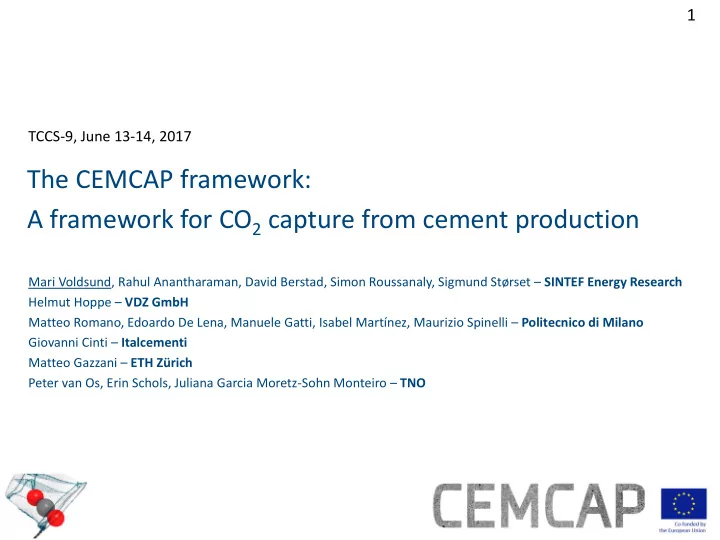

1 1 TCCS-9, June 13-14, 2017 The CEMCAP framework: A framework for CO 2 capture from cement production Mari Voldsund, Rahul Anantharaman, David Berstad, Simon Roussanaly, Sigmund Størset – SINTEF Energy Research Helmut Hoppe – VDZ GmbH Matteo Romano, Edoardo De Lena, Manuele Gatti, Isabel Martínez, Maurizio Spinelli – Politecnico di Milano Giovanni Cinti – Italcementi Matteo Gazzani – ETH Zürich Peter van Os, Erin Schols, Juliana Garcia Moretz-Sohn Monteiro – TNO Technology for a better society
2 Outline • Background • Framework overview • Reference cement burning line • CO 2 capture utilities • Concluding remarks Technology for a better society
3 Background • 7-9% of global anthropogenic CO 2 emissions from the cement industry • CO 2 emissions an inherent part of the cement production process CaCO 3 → CaO + CO 2 Technology for a better society
4 CEMCAP: Four fundamentally different technologies investigated Oxyfuel Chilled ammonia process (CAP) • Combustion in O 2 (not air) gives CO 2 -rich flue gas • NH 3 /water mixture as liquid solvent • Require: oxygen • Require: heat for solvent regeneration, el for refrigeration • Generate: power from waste heat Power Fuel Cement plant CO 2 Raw meal Clinker Membrane-assisted liquefaction (MAL) Calcium looping (CaL) • Polymeric membrane for flue gas CO 2 enrichment followed by • CaO reacts with CO 2 to form CaCO 3 • Require: heat for sorbent regeneration, oxygen CO 2 liquefaction • Require: El for refrigeration and compression • Generate: power from waste heat Technology for a better society
5 CEMCAP framework • For consistent comparative assessment of capture technologies • Provides information relevant for experimental and simulation work • Suitable for use also outside of CEMCAP • The framework contains: • A reference cement burning line • Process unit specifications • Utilities – cost and climate impact • CO 2 specifications • Economic parameters • Key performance indicators Technology for a better society
6 Reference cement burning line • All cement burning lines are different: 14-35 vol% CO 2 (dry basis) • Reference cement burning line • Based on reference cement kiln of ECRA • 3,000 tonne clinker per day • Assumed BAT technologies • Defines • raw material • fuel properties • process components • etc. Technology for a better society
7 Flue gas concentrations Concentrations at stack (dry basis) Interconnected Direct Air leak Low Medium - CO 2 [vol%] 25 20 34 N 2 [vol%] 67 69 63 O 2 [vol%] 8 11 3 • Increasing air leak (base case) • Constant low air leak Technology for a better society
8 Steam • No steam generated at the plant • Small amount of waste heat • Assume required steam is generated by: Climate Cost (2014) impact Steam source • Waste heat recovery [ € /MWh th ] [kg CO2 /MWh th ] • Waste heat available on the plant 0 8.5 And either Natural gas boiler 224 25.3 • Natural gas fired boiler (base case) External CHP steam plant at 100 ° C 101 7.7 • External CHP External CHP steam plant at 120 ° C 136 10.3 External CHP steam plant at 140 ° C 170 13.0 Technology for a better society
9 Electricity EU-28 total: • Fuel consumption per fuel in EU-28 (Eurostat) • Electric efficiency • Electricity generation per fuel in EU-28 (Eurostat) • Climate impact • CO 2 emission factors of fuels (IEA) • State-of-the-art efficiency and climate impact (EU directive) Electric Climate impact (2014) efficiency (2014) [kg CO2 /MWh] [%] EU-28 total 45.9 262 Pulverized coal, state-of-the-art 44.2 770 Pulverized coal, sub-critical 35.0 973 NGCC 52.5 385 Renewables (100% efficiency) 1 0 ∞ Renewables (infinite efficiency) 0 • Cost of electricity EU-28 (Eurostat) Cost (2014) Yearly electricity demand [ € /MWh el ] 20,000 – 70,000 MWh/y 0.0548 70,000 – 150,000 MWh/y 0.0509 Technology for a better society
10 Integrated power production • Conventional kilns: heat recovery steam cycles seldom adopted • CEMCAP integrated power production based on waste-to-energy cycles Nominal thermal input, MW 12.5 25 50 100 200 300 Steam pressure at turbine inlet, bar 30 40 60 80 100 125 Steam temperature at turbine inlet, ° C 350 400 460 480 530 565 LP regenerative condensate preheater No No Yes Yes Yes Yes Feedwater temperature at boiler inlet, ° C 120 120 140 140 140 140 Estimated turbine isentropic efficiency, % 70.0 75.0 78.0 80.8 85.6 86.8 90 Estimated turbine isentropic 85 efficiency [%] 80 75 70 65 - 50 100 150 200 250 300 350 Technology for a better society Nominal thermal input, MW
11 Oxygen supply • Two relevant alternatives of oxygen supply: • Production on-site in air separation unit (ASU) • Production outside the site and deliverance by tank trucks to storage tanks Supply method Power consumption Cost 66-91 € /t O2 ASU 220-400 kWh/t O2 80-100 € /t O2 Tank trucks - • Costs versus flexibility Technology for a better society
12 Refrigeration • Coefficient of performance versus evaporator temperature 𝑅 refrigeration COP = 𝑋 net CoolPack Technology for a better society
13 Concluding remarks • Have presented: • Reference cement burning line • Utilities • You can also find: • Process unit specifications • CO 2 specifications • Economic parameters • Key performance indicators • Information source for studies on CO 2 capture from cement production • Available at: http://www.sintef.no/projectweb/cemcap/results/ Technology for a better society
14 14 Acknowledgements This project has received funding from the European Union's Horizon 2020 research and innovation programme under grant agreement no 641185 This work was supported by the Swiss State Secretariat for Education, Research and Innovation (SERI) under contract number 15.0160 www.sintef.no/cemcap Twitter: @CEMCAP_CO2 Technology for a better society
Recommend
More recommend